Layout and features
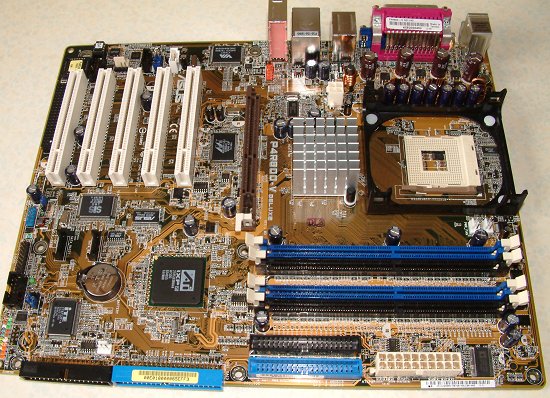
ASUS never decided to jump on the PCB colour bandwagon. ASUS boards are difficult to differentiate from one another, and the simplest method is to take a look at the board's imprinted name. ATI's 9100 IGP takes a familiar North/Southbridge chipset route, with the 9100 IGP paired up alongside the IXP150 Southbridge. The CPU socket area is relatively clean. A passive Northbridge heatsink doesn't interfere with cooler mounting. ASUS has chosen to locate the 4-pin power connector on the far side of the board, so it's best to push the wire behind the CPU's heatsink.
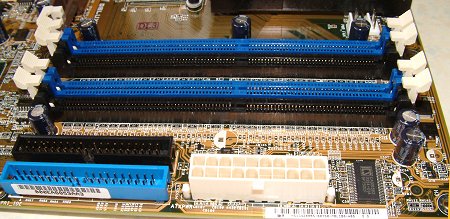
A few words about the chipset itself. The 9100 IGP Northbridge, or RS300, supports all current S478 processers. That list includes CPUs operating from 400MHz, 533MHz, and 800MHz FSBs, respectively. In accordance with CPU FSB speeds, the RS300 also supports dual-channel memory at DDR266, DDR333, and DDR400 (only 2 modules out of 4) speeds. That sounds scarily similar to Intel's dual-channel offerings, but ATI goes a step further by amalgamating a DX8.1-compatible GPU right on the 0.15-micron NB. It's not just a token gesture from ATI, for the 9100 IGP features 2 rendering pipelines operating at ~300MHz, pixel shader spec. 1.4 in hardware, and up to 6x FSAA (800x600) and 16x AF image enhancement support. Of course, memory bandwidth is dictated and derived from system RAM. There's also the usual ATI gamut of 2D features. An i865G-beater on paper, even though vertex shading is offloaded to the CPU.
Back to the ASUS board. 4 DIMM slots can only be populated with memory rated to DDR333 speeds. DDR400 running, as mentioned, limits system memory to 2 modules and consequently 2GB of RAM. That's not a problem for the board's intended market. We're pleased to see the main 20-pin power connector located on the near side; it makes for cleaner cable installation. Primary and secondary IDE ports are situated nearby.

Moving on down the board finds the IXP150 Southbridge. Unlike Intel, ATI has at least 3 different Southbridges to pair up with the RS300, which comprise of the IXP250, IXP200 and IXP150. ASUS goes with the IXP150 and misses out on 3COM MAC support. ATI's Southbridges are a feature disappointment. There's no on-chip SATA or FireWire support, for instance. ASUS has engineered around that problem by using discrete controllers from, amongst others, SiS, Marvell, and VIA.
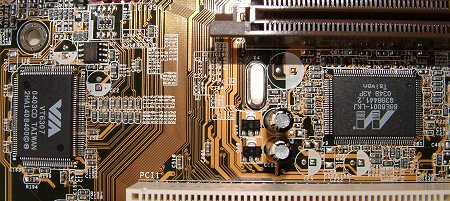
VIA's ubiquitous VT6307 2-port FireWire400 ASIC and Marvell's 88E001 Gigabit LAN controller sit between the AGP and first of five PCI slots. The extra PCB space afforded to the ASICs allows users to actually use the first PCI slot without obstructing most graphics cards' airflow. Both ASICs are low-cost measures that should have been made redundant by a better-equipped Southbridge, really. Not ASUS' fault, however. Another nice touch from ASUS is the colour coded motherboard-to-case pins.. Certainly makes for easier installation. What's extremely annoying, however, is the proximity of the DDR slot locks to the AGP slot. The slots and locks are far enough down to interfere with any card that uses a rear-mounted heatsink.
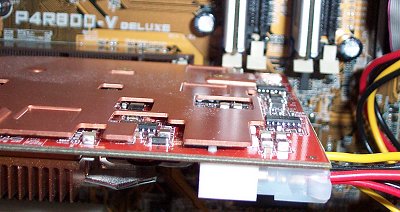
An ASUS Radeon 9800 XT card cannot be installed in a manner that doesn't make contact with the first slot lock, so it's difficult to ensure the card is fully engaging the AGP port. Bad, thoughtless design on ASUS' part.
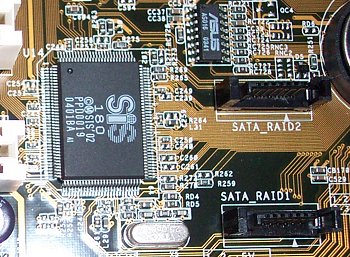
SiS' 180 PCI-based RAID controller is much like Promise's, that is, it can manage 2 SATA drives and a couple of regular PATA drives running off a regular IDE port. RAID0, 1, 0+1, and JBOD (Just a Bunch of Disks) configurations can be selected. There's enough scope here to create esoteric arrays. The problem for the SiS 180, and one that's endemic with all discrete controllers, is the need to use the PCI bus. Count up the possible bandwidth tax imposed by Gigabit LAN, FireWire 400, buckets of USB 2.0, and SATA. It's easy to see how the bus can be throttled. Having a 266MB/s bridge interconnect speed doesn't do much to alleviate the problem, either.

The right-hand connector runs off the aforementioned SiS 180 hybrid controller. ASUS chooses an interesting position to mount the floppy port. Both connectors are rotated in true ASUS style. ASUS appears to be one of the few ADI 1888 6-channel AC'97 v2.3 CODEC users. From what we've seen and heard before, ADI, when allied with SoundMax software, produce excellent, low-cost sound CODECs. Another plus for this multimedia board. The automatic jack-sensing technology is nice. ASUS also includes a Wi-Fi slot, but the user needs to realise that an add-in card is still required.

An interesting assortment of ports and sockets. The multimedia nature is out in force. No less than 3 forms of video output; composite, S-Video, and HD15, in that order, sit next to the usual two PS/2 ports. A slight problem that we ran into was the inability to use a USB key in the port next to the HD15 output, assuming that the video connection was used. 4 USB 2.0 ports, a single FireWire400 and the RJ45 socket for Gigabit LAN are all expected features. Another two USB 2.0 ports emanate from a board header. Lastly, ADI's CODEC feeds the 3 jack-sensing audio ports, which double-up for 6-channel sound.
Pretty good design that's letdown by awful DDR slot positioning.









